The Drill Bit Market is estimated to be valued at USD 17.8 billion in 2025 and is projected to reach USD 29.0 billion by 2035, registering a compound annual growth rate (CAGR) of 5.0% over the forecast period. This early-phase growth is driven by increasing demand across industries such as oil and gas, mining, and construction, along with technological advancements in drill bit materials and designs. The market will benefit from the expansion of energy exploration, infrastructure projects, and the need for efficient drilling solutions in challenging environments.
The second half (2030–2035) will contribute USD 7.3 billion, representing 61.7% of the total growth, reflecting continued demand driven by advanced drilling technology, high-performance materials, and a rising focus on sustainability in energy extraction. Annual increments average USD 1.4 billion per year in the later phase, driven by industry-specific innovations such as high-pressure, high-temperature (HPHT) drilling and extended-life drill bits. Manufacturers focusing on precision-engineered, cost-effective solutions will capture the largest share of this USD 12.2 billion growth opportunity as demand continues to rise in global markets.
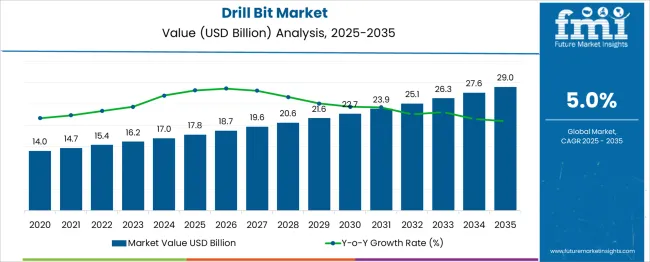
| Metric | Value |
|---|---|
| Drill Bit Market Estimated Value in (2025 E) | USD 17.8 billion |
| Drill Bit Market Forecast Value in (2035 F) | USD 29.0 billion |
| Forecast CAGR (2025 to 2035) | 5.0% |
The drill bit market is witnessing robust expansion as exploration and production companies continue to push boundaries in unconventional and deep-water drilling operations. Growth is being influenced by rising global energy demand, aggressive upstream investments, and enhanced focus on cost-efficiency in hydrocarbon extraction. Technology innovation has emerged as a major driver, particularly in bit design and material engineering, enabling greater drilling accuracy, durability, and adaptability in extreme geologies.
Drill bits are evolving into high-performance tools powered by simulation-driven design, dynamic cutter layouts, and thermally stable materials. Manufacturers are integrating vibration mitigation, self-sharpening mechanisms, and data feedback sensors to optimize bottom-hole assembly performance. Increasing shale gas activity, coupled with recovery in offshore drilling, is expected to sustain long-term demand.
Additionally, emphasis on reducing non-productive time and improving wellbore quality is promoting the use of advanced bit technologies. The market outlook remains strong as industry players continue to enhance operational efficiency through software-enabled bit selection and real-time optimization platforms.
The drill bit market is segmented by type, material, bit size, application, end-use industry, and geographic regions. By type, the drill bit market is divided into Fixed Cutter Bits, Roller Cone Bits, and Others. In terms of material, the drill bit market is classified into Diamond, Steel, Tungsten Carbide, and Others. Based on the bit size, the drill bit market is segmented into 5–10 inches, below 5 inches, and above 10 inches. By application, the drill bit market is segmented into Onshore and Offshore. The end-use industry of the drill bit market is segmented into Oil & Gas, Mining, Construction, and Others. Regionally, the drill bit industry is classified into North America, Latin America, Western Europe, Eastern Europe, Balkan & Baltic Countries, Russia & Belarus, Central Asia, East Asia, South Asia & Pacific, and the Middle East & Africa.

The fixed cutter bits segment is projected to account for 56.8% of the total revenue share in the drill bit market by 2025. The leading position of this segment is supported by its higher durability, longer operational lifespan, and ability to deliver a faster rate of penetration in various rock formations. Fixed cutter bits, particularly polycrystalline diamond compact (PDC) variants, have been increasingly adopted due to their minimal moving parts and consistent cutting structure, reducing the risk of mechanical failure in high-pressure environments.
Their suitability for directional and horizontal drilling has further driven uptake in complex well profiles, especially in shale and tight formations. The integration of wear-resistant materials and optimized blade geometry has significantly improved performance in hard rock conditions.
Continuous innovations in bit body design and cutter placement have enabled smoother drilling with reduced vibration, enhancing operational efficiency. As operators increasingly prioritize drilling performance and cost savings, fixed cutter bits are expected to remain the preferred choice for a wide range of applications.
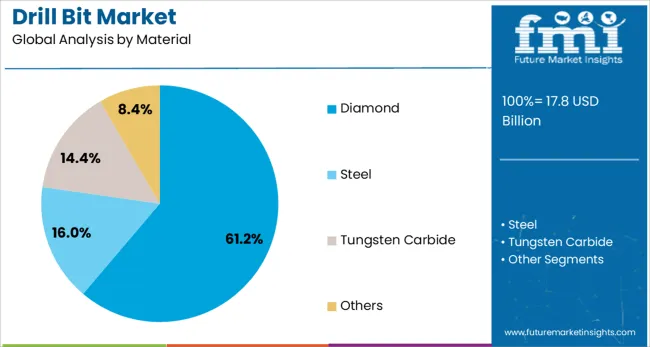
The diamond material segment is anticipated to capture 61.2% of the drill bit market’s revenue share in 2025, making it the most dominant material category. The dominance of this segment is being influenced by the superior hardness, thermal stability, and wear resistance offered by diamond-based compositions. Diamond bits, particularly those using synthetic diamonds such as PDC, are widely used in hard and abrasive formations due to their ability to maintain cutting efficiency over extended durations.
The long operational life of diamond bits translates to fewer bit trips, reduced downtime, and lower overall drilling costs. Continuous advancements in synthetic diamond technology have improved thermal resistance and cutting edge retention, further enhancing their suitability for high-speed drilling.
The shift toward deeper wells and more challenging drilling environments has increased demand for materials that can sustain extreme conditions without performance degradation. As drilling requirements evolve, diamond materials are expected to retain their leadership due to their unmatched durability and cutting precision.
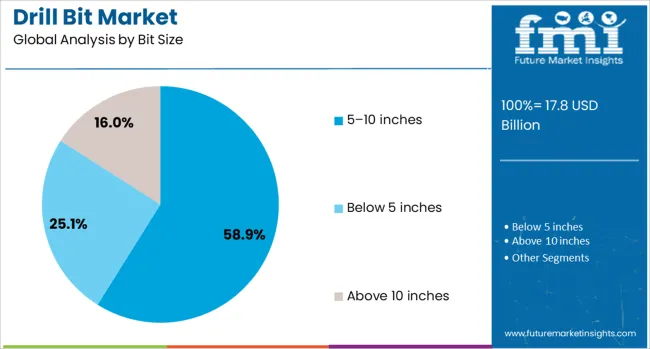
The 5 to 10 inches bit size segment is forecast to hold 58.9% of the total revenue share in the drill bit market by 2025, reflecting its strong preference in both onshore and offshore drilling projects. This bit size range is favored for its versatility across a broad range of well profiles and formation types.
The segment’s leading share is driven by its compatibility with standard borehole diameters used in oil and gas exploration, enabling efficient drilling without compromising structural integrity. Tools in this size category offer an optimal balance between penetration rate and steering control, making them ideal for directional and deviated wells.
The segment has benefited from ongoing R&D efforts focused on optimizing hydraulic flow, bit profile geometry, and cutter exposure, all of which contribute to reduced torque fluctuations and improved drilling speed. As operators seek more agile and cost-effective solutions in both conventional and unconventional reservoirs, the 5 to 10-inch size category is expected to remain a widely adopted standard in drilling operations.
The drill bit market is expanding due to the increased demand for energy and mineral resources globally. Key growth drivers include the rise in exploration activities and construction projects. Opportunities exist in the development of advanced, durable drill bits for various industries. Emerging trends include the demand for specialized drill bits in unconventional oil and gas exploration. However, high costs of raw materials and stringent regulations may limit the market’s growth in certain regions.
The major growth driver in the drill bit market is the increasing demand for energy and minerals. In 2024, the global demand for fossil fuels, coupled with ongoing exploration activities, has driven the need for more efficient and durable drill bits. The expansion of offshore oil and gas exploration, especially in deepwater and unconventional reservoirs, is anticipated to propel market growth into 2025. As energy demands grow, drill bit manufacturers are expected to see increased opportunities for innovation.
The major opportunities in the drill bit market are emerging from the need for specialized bits in unconventional oil and gas exploration. In 2024, the shift toward shale gas and tight oil exploration created a demand for more robust and efficient drill bits. This trend is expected to continue through 2025, with companies focusing on developing drill bits capable of handling the unique challenges of deep drilling, hard rock, and high-temperature environments, offering substantial market potential for specialized products.
An emerging trend in the drill bit market is the growing preference for high-performance and customized drill bits. In 2024, the demand for drill bits that can withstand extreme drilling conditions and improve operational efficiency saw a significant rise. By 2025, the trend is expected to intensify, with customized drill bits for specific tasks and materials becoming increasingly common. This shift towards specialized products is driven by industries seeking to optimize drilling processes, reduce downtime, and improve cost-effectiveness.
A key restraint in the drill bit market is the high cost of raw materials. In 2024, the rising prices of materials like tungsten carbide, which are essential for producing durable drill bits, have made manufacturing more expensive. This, in turn, has led to higher product prices, affecting demand, particularly in price-sensitive markets. Regulatory challenges, particularly in terms of environmental compliance in drilling activities, are also expected to limit growth, especially in regions with strict environmental policies.
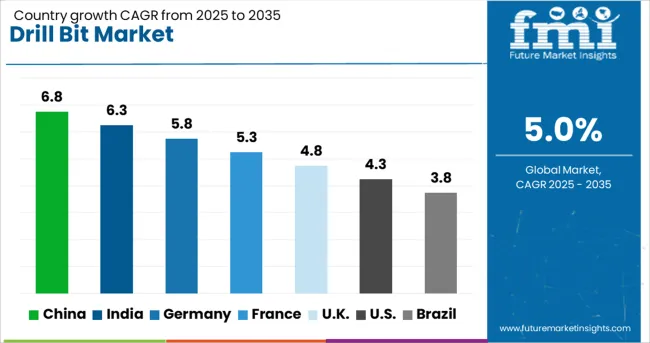
| Country | CAGR |
|---|---|
| China | 6.8% |
| India | 6.3% |
| Germany | 5.8% |
| France | 5.3% |
| UK | 4.8% |
| USA | 4.3% |
| Brazil | 3.8% |
The global drill bit market is projected to grow at a 5% CAGR from 2025 to 2035. China leads with a growth rate of 6.8%, followed by India at 6.3%, and Germany at 5.8%. The United Kingdom records a growth rate of 4.8%, while the United States shows the slowest growth at 4.3%. These variations in growth rates are influenced by factors such as industrial development, demand from the oil and gas, mining, and construction sectors, and technological advancements in drilling equipment. While emerging markets like China and India are experiencing rapid growth due to industrialization and infrastructure expansion, more mature markets like the USA and the UK show steady growth driven by established demand and technological upgrades.
The drill bit market in China is growing at a strong pace, with a projected CAGR of 6.8%. China’s rapid industrialization and expansion in sectors such as oil and gas, mining, and construction are key drivers of this market. The country’s increasing demand for drilling equipment, particularly for deep drilling and precision applications, is contributing to the growth of the market. Additionally, China’s growing infrastructure projects, coupled with investments in energy exploration, further enhance the demand for high-performance drill bits. Technological innovations in drill bit designs to enhance efficiency and reduce costs are also accelerating market growth.
The drill bit market in India is projected to grow at a CAGR of 6.3%. India’s growing construction, mining, and energy sectors are major contributors to the rising demand for drill bits. As the country invests in infrastructure projects and increases its mining and energy exploration activities, the demand for advanced drilling equipment is expected to rise significantly. Additionally, India’s expanding oil and gas sector, alongside an increasing number of construction and real estate projects, is further boosting the need for efficient and durable drill bits. The market is also benefiting from government initiatives to improve industrial production and energy infrastructure.
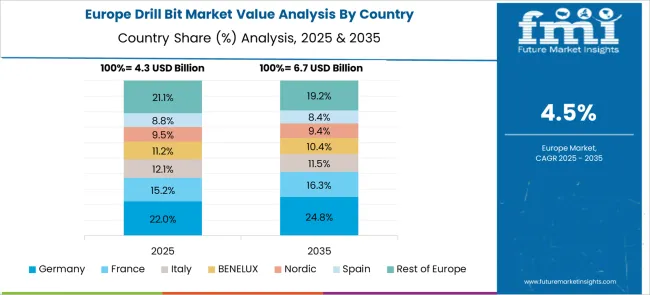
The drill bit market in Germany is projected to grow at a CAGR of 5.8%. Germany, known for its strong industrial base, particularly in manufacturing, automotive, and energy sectors, is witnessing a steady demand for advanced drill bits. The country’s focus on precision manufacturing and high-performance drilling applications is contributing to the market’s growth. Germany’s investments in renewable energy sources, especially wind energy, and deep drilling technologies are also expanding the need for specialized drill bits. Additionally, Germany’s strong position in the European market and ongoing industrial automation initiatives further fuel the demand for reliable and efficient drill bits.
The drill bit market in the United Kingdom is projected to grow at a CAGR of 4.8%. The UK’s industrial sector, particularly in construction, mining, and oil and gas, continues to drive the demand for drill bits. Although market growth is slower compared to emerging economies, the steady demand for drill bits, driven by infrastructure projects and oil exploration, ensures a consistent market expansion. Additionally, the shift toward renewable energy and sustainable drilling methods is encouraging the adoption of more efficient and eco-friendly drilling technologies in the UK, further fueling the demand for advanced drill bits.
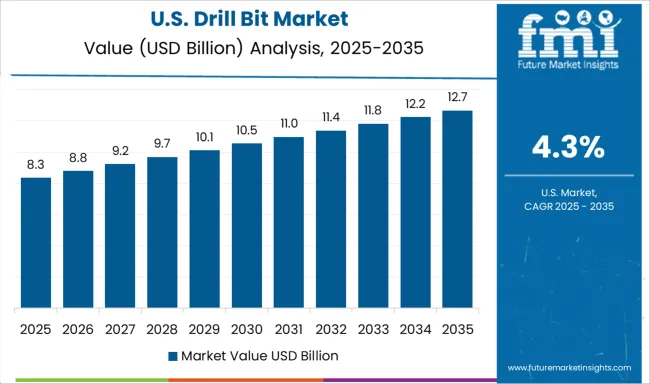
The drill bit market in the United States is expected to grow at a CAGR of 4.3%. The USA remains a major player in the global drill bit market, particularly in the oil, gas, and mining industries. While the market is mature, ongoing demand for drilling equipment for both traditional and unconventional energy exploration continues to support growth. Technological advancements in drill bit designs to improve performance, reduce costs, and meet specific drilling requirements also contribute to the market's stability. The USA market is also influenced by investments in automation and efficient energy extraction techniques.
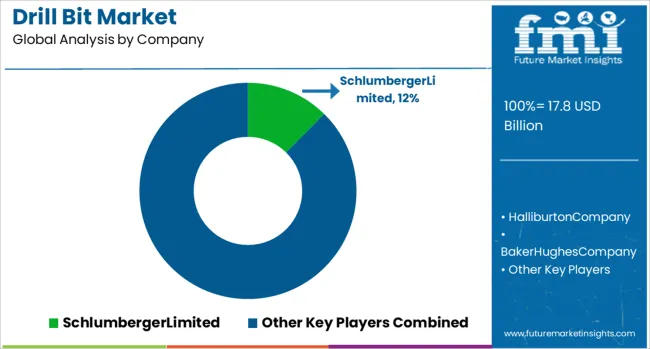
The drill bit market is dominated by Schlumberger Limited, which leads with its comprehensive range of high-performance drill bits used in oil and gas exploration, mining, and construction industries. Schlumberger’s dominance is reinforced by its advanced technology, strong global presence, and innovative designs that optimize drilling efficiency and reduce operational costs. Key players such as Halliburton Company, Baker Hughes Company, and National Oilwell Varco Inc. maintain significant market shares by offering specialized drill bits designed for various drilling environments, including high-pressure, high-temperature conditions. These companies focus on providing durable, cost-effective solutions for the oil and gas, mining, and construction sectors, ensuring optimal drilling performance and reliability.
Emerging players like Sandvik AB, Varel International Energy Services, and Ulterra Drilling Technologies are expanding their presence by offering more customized drill bit solutions, including specialized bits for directional drilling, offshore applications, and hard rock formations. Their strategies include improving bit design, material strength, and cutting-edge technologies such as PDC (polycrystalline diamond compact) and roller cone drill bits. Market growth is driven by the increasing demand for energy, expanding mining operations, and the rise of unconventional oil and gas extraction techniques. Innovations in drill bit technology, such as enhanced durability, wear resistance, and automation in drilling processes, are expected to continue shaping competitive dynamics and fuel growth in the global drill bit market.
Global leaders such as Sandvik, Baker Hughes, Halliburton, Schlumberger, and Stanley Black & Decker dominate the premium tier. Their advantage lies in scale, technological innovation, and global distribution. These companies compete through portfolios spanning rotary, PDC (polycrystalline diamond compact), and roller cone drill bits, with positioning built around durability, drilling efficiency, and performance in harsh geological environments. Digital integration is increasingly emphasized, with drill bits marketed not only as consumables but as components embedded within smart drilling systems that generate performance data for optimization. Specialist competitors, including firms like Varel International, Regal Cutting Tools, and Triumph Twist Drill, occupy a mid-tier niche. Their strength is focus and adaptability. They emphasize engineered customization, catering to specific formations in oilfield drilling or precision machining in industrial and aerospace sectors. Their positioning is reinforced by faster innovation cycles and a willingness to tailor geometries, coatings, or materials for unique applications. While they lack the scale of multinationals, they capture loyalty among customers who require specialized solutions and faster turnaround. Regional players, especially in Asia-Pacific, Eastern Europe, and the Middle East, compete largely on cost efficiency. Their focus is commodity-grade drill bits for construction, mining, and general industrial use. Distribution is heavily reliant on dealer networks, and while product lifespans are shorter, affordability and local availability ensure steady demand in cost-sensitive projects.
| Item | Value |
|---|---|
| Quantitative Units | USD 17.8 Billion |
| Type | Fixed Cutter Bits, Roller Cone Bits, and Others |
| Material | Diamond, Steel, Tungsten Carbide, and Others |
| Bit Size | 5–10 inches, Below 5 inches, and Above 10 inches |
| Application | Onshore and Offshore |
| End-Use Industry | Oil & Gas, Mining, Construction, and Others |
| Regions Covered | North America, Europe, Asia-Pacific, Latin America, Middle East & Africa |
| Country Covered | United States, Canada, Germany, France, United Kingdom, China, Japan, India, Brazil, South Africa |
| Key Companies Profiled | SchlumbergerLimited, HalliburtonCompany, BakerHughesCompany, NationalOilwellVarcoInc., WeatherfordInternationalplc, SandvikAB, VarelInternationalEnergyServices, DrilformanceLLC, UlterraDrillingTechnologies, AtlasCopcoAB, TorquatoDrillingAccessories, Volgaburmash, DrillKingInternational, ScientificDrillingInternational, RockpeckerLimited, GeneralElectricCompany(GEOil&Gas), KingdreamPublicLimitedCompany, HoleProducts, CaterpillarInc.(forconstructionbits), and RobitPlc |
| Additional Attributes | Dollar sales by bit type and application, demand dynamics across oil and gas, construction, and mining sectors, regional trends in drill bit adoption, innovation in materials for durability and efficiency, impact of regulatory standards on safety and environmental concerns, and emerging use cases in automated drilling and precision cutting. |
The global drill bit market is estimated to be valued at USD 17.8 billion in 2025.
The market size for the drill bit market is projected to reach USD 29.0 billion by 2035.
The drill bit market is expected to grow at a 5.0% CAGR between 2025 and 2035.
The key product types in drill bit market are fixed cutter bits, roller cone bits and others.
In terms of material, diamond segment to command 61.2% share in the drill bit market in 2025.






Full Research Suite comprises of:
Market outlook & trends analysis
Interviews & case studies
Strategic recommendations
Vendor profiles & capabilities analysis
5-year forecasts
8 regions and 60+ country-level data splits
Market segment data splits
12 months of continuous data updates
DELIVERED AS:
PDF EXCEL ONLINE
PDC Drill Bits Market Size and Share Forecast Outlook 2025 to 2035
Oil Field Drill Bits Market Growth - Trends & Forecast 2025 to 2035
Drilling Tools Market Size and Share Forecast Outlook 2025 to 2035
Drill Drivers Market Size and Share Forecast Outlook 2025 to 2035
Drill Shank Adapter Market Size and Share Forecast Outlook 2025 to 2035
Drilling Type EDM Market Size and Share Forecast Outlook 2025 to 2035
Drill Pipe Market Size and Share Forecast Outlook 2025 to 2035
Drilling Machines Market Size and Share Forecast Outlook 2025 to 2035
Drilling and Completion Fluids Market Diapers Market Analysis - Size, Share & Forecast 2025 to 2035
Drilling Polymers Market Analysis, Growth, Applications and Outlook 2025 to 2035
Rock Drill Shank Adaptor Market Size and Share Forecast Outlook 2025 to 2035
Core Drill Automatic Feeding Machine Market
Sinker Drill Market Size and Share Forecast Outlook 2025 to 2035
Mining Drilling Service Market Size and Share Forecast Outlook 2025 to 2035
Rotary Drilling Rig Market Size and Share Forecast Outlook 2025 to 2035
Radial Drilling Machine Market Growth & Demand 2025 to 2035
Mining Drill Market Growth – Trends & Forecast 2025 to 2035
Onshore Drilling Waste Management Market Size and Share Forecast Outlook 2025 to 2035
Onshore Drilling Fluids Market Growth - Trends & Forecast 2025 to 2035
Crawler Drilling Machine Market

Thank you!
You will receive an email from our Business Development Manager. Please be sure to check your SPAM/JUNK folder too.
Chat With
MaRIA